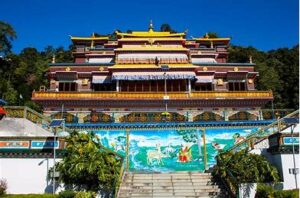Hajo is a historically significant town located in the Kamrup district of Assam, India. Renowned for its religious and cultural diversity, Hajo is considered a prominent pilgrimage center for three major religious communities—Hindus, Muslims, and Buddhists. The town, situated on the banks of the Brahmaputra River, has attracted devotees for centuries due to its sacred temples, mosques, and monasteries. Its significance stems not only from its religious importance but also from its unique ability to unite different faiths in one geographic and spiritual space.
In this blog, we will explore the rich history, religious heritage, and the cultural significance of Hajo as a place of pilgrimage for Hindus, Muslims, and Buddhists. We will delve into the architectural landmarks, historical events, and the unique religious practices that make this town one of the most fascinating pilgrimage destinations in Assam.
Hajo – A Brief Overview
Hajo is situated approximately 24 kilometers west of Guwahati, the largest city in Assam. It is nestled in the northern part of the state and is easily accessible from Guwahati via road. The town’s location along the Brahmaputra River has further enhanced its appeal as a spiritual hub, with riverfront views offering a serene and contemplative atmosphere for pilgrims and visitors.
The town has long been known for its historical importance. It is believed to have been an important center of trade, culture, and religion during ancient times. Over the centuries, Hajo developed into a focal point for people of different religious beliefs, where Hindus, Muslims, and Buddhists have coexisted harmoniously. This unique blend of religious traditions has led to the creation of various temples, mosques, and stupas in the area, each serving as a place of worship and reflection for their respective communities.
Hajo as a Hindu Pilgrimage Center
For Hindus, Hajo is considered one of the holiest places in Assam, home to several ancient temples dedicated to Hindu deities. Among the most important Hindu sites in Hajo is the Hayagriva Madhava Temple, a major pilgrimage destination for followers of the Vaishnavite tradition. The temple is dedicated to Lord Hayagriva, an incarnation of Lord Vishnu, known for his horse-like head. According to Hindu mythology, Hayagriva is the deity who is believed to have restored the lost Vedas (ancient Hindu scriptures) to Lord Brahma.
The Hayagriva Madhava Temple is believed to date back to the 6th century and has been a significant center for religious worship and cultural gatherings. The temple’s architecture is a testament to the region’s historical artistic heritage, blending traditional Assamese design with Vaishnavite elements. The temple is especially busy during the Bihu Festival, an important Assamese cultural festival that marks the start of the agricultural year.
Another important Hindu site in Hajo is the Kedar Temple, dedicated to Lord Shiva. The Kedar Temple is believed to have been built by King Rudra Singha, a famous ruler of Assam during the 17th century. Pilgrims visit the temple to offer prayers to Lord Shiva, particularly during the Maha Shivaratri festival, which draws large crowds every year.
In addition to these temples, Hajo is also known for its vibrant Durga Puja celebrations, which see devotees gather in large numbers from across Assam and neighboring regions. The town’s spiritual atmosphere during major Hindu festivals further strengthens its reputation as a key center of Hindu pilgrimage.
Hajo as a Muslim Pilgrimage Center
Hajo is also of great significance to Muslims, particularly due to the presence of the Mausoleum of Pir Giasuddin Auliya. Pir Giasuddin Auliya, a revered Sufi saint, is believed to have arrived in Assam during the 14th century and spread the message of peace, love, and harmony. His mausoleum is located on a hilltop in Hajo, and it remains one of the most important sites for Muslim pilgrims.
The mausoleum itself is a symbol of the Sufi tradition and the spiritual connection between the divine and human beings. The shrine is visited by thousands of Muslims, especially during the Urs festival, which marks the death anniversary of Pir Giasuddin Auliya. During this time, pilgrims offer prayers, perform rituals, and seek blessings for prosperity, health, and spiritual growth.
The presence of the mausoleum in Hajo highlights the town’s role as a cross-cultural and interfaith center. It serves as an example of how different religious communities have coexisted and respected each other’s beliefs throughout history. This interfaith harmony is a key feature of Hajo’s identity as a pilgrimage center.
Hajo as a Buddhist Pilgrimage Center
In addition to its Hindu and Muslim significance, Hajo also holds importance for Buddhists, primarily due to the presence of Buddhist Stupas and monasteries in the area. The town is believed to have been a center of Buddhist activity in ancient times, with several Buddhist rulers and monks having visited or resided in the region. The Ganesha Temple, located on a hilltop in Hajo, is often associated with Buddhist influences, as the surrounding area is home to several stupas, a key feature of Buddhist religious architecture.
One of the most notable Buddhist landmarks in Hajo is the Powa Mecca Stupa. According to local legend, the stupa houses a relic of the Prophet Muhammad, brought to Assam by a group of Muslim traders. Buddhists, particularly those following the Theravada tradition, also visit this site to pay homage to the Buddha’s teachings and relics.
Hajo’s significance in Buddhism is further emphasized by the presence of several monasteries that house monks and nuns from various Buddhist traditions. Pilgrims from different parts of Assam and beyond visit these monasteries for meditation, spiritual learning, and to participate in Buddhist rituals.
Cultural and Religious Harmony in Hajo
One of the most striking aspects of Hajo is its ability to blend different religious practices into a cohesive spiritual experience. The town stands as a symbol of religious tolerance and unity, with Hindu temples, Muslim shrines, and Buddhist stupas coexisting peacefully in the same geographic area. Pilgrims from different faiths can often be seen paying their respects at multiple sites, a testament to the inclusive and pluralistic nature of Hajo’s religious landscape.
This religious harmony is not limited to the buildings and rituals but also extends to the people. The locals of Hajo have long embraced diversity, and the town has become a model of peaceful coexistence among different religious communities. People from all walks of life, irrespective of their religious backgrounds, participate in the various festivals and rituals held throughout the year.
Conclusion
Hajo is a unique and historically significant town that holds deep spiritual importance for Hindus, Muslims, and Buddhists. It is a place where religious diversity is celebrated, and where ancient temples, mosques, and stupas stand as enduring symbols of faith, devotion, and cultural heritage. For centuries, Hajo has been a center of pilgrimage, attracting devotees from across India and beyond. Its rich religious and cultural legacy continues to be an essential part of the spiritual fabric of Assam and the broader Indian subcontinent. As a place where three major religions converge, Hajo stands as a testament to the power of faith in uniting people from diverse backgrounds in a shared quest for spiritual fulfillment.




